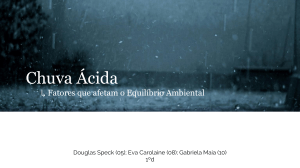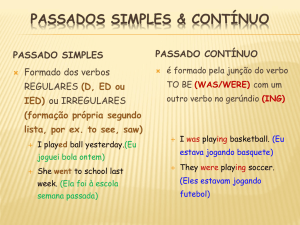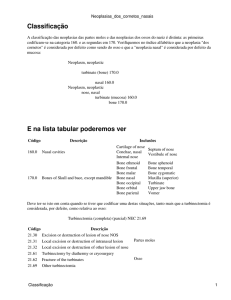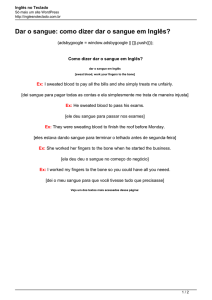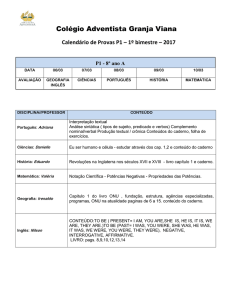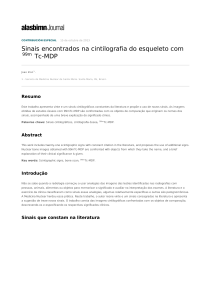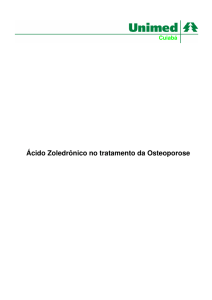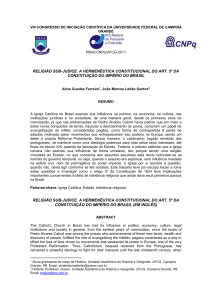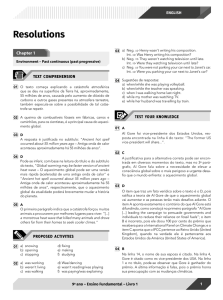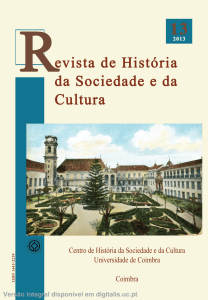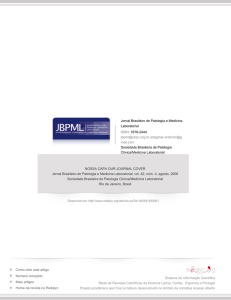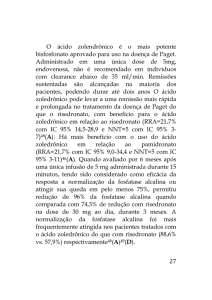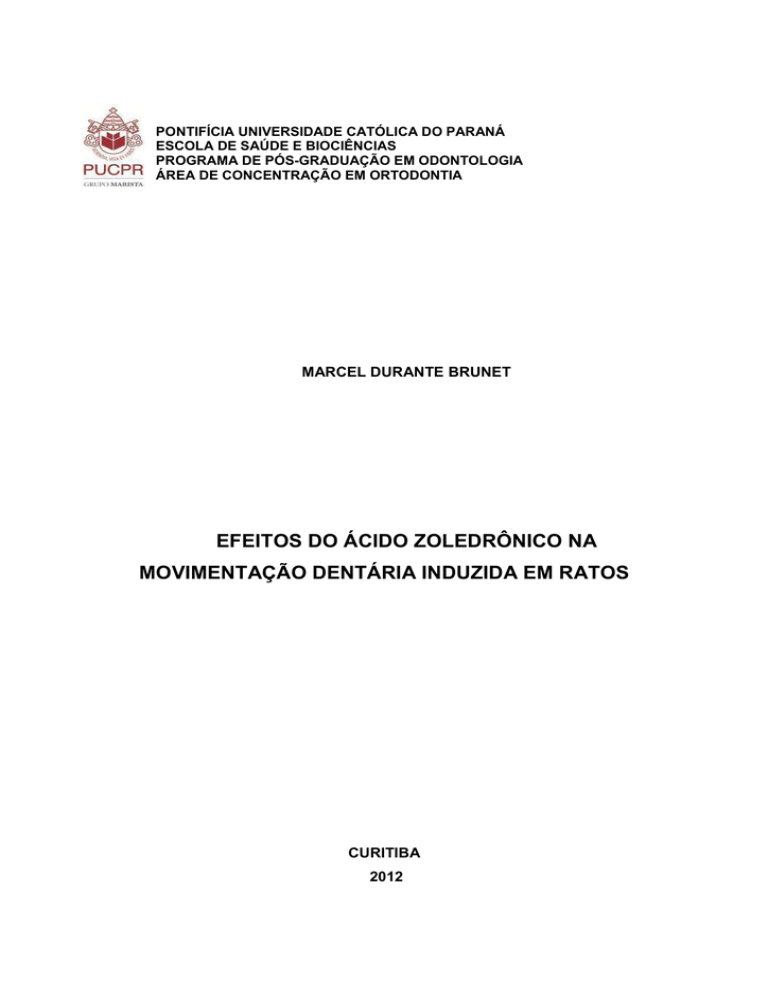
PONTIFÍCIA UNIVERSIDADE CATÓLICA DO PARANÁ
ESCOLA DE SAÚDE E BIOCIÊNCIAS
PROGRAMA DE PÓS-GRADUAÇÃO EM ODONTOLOGIA
ÁREA DE CONCENTRAÇÃO EM ORTODONTIA
MARCEL DURANTE BRUNET
EFEITOS DO ÁCIDO ZOLEDRÔNICO NA
MOVIMENTAÇÃO DENTÁRIA INDUZIDA EM RATOS
CURITIBA
2012
MARCEL DURANTE BRUNET
EFEITOS DO ÁCIDO ZOLEDRÔNICO NA
MOVIMENTAÇÃO DENTÁRIA INDUZIDA EM RATOS
Dissertação apresentada ao Programa de PósGraduação
em
Odontologia
da
Pontifícia
Universidade Católica do Paraná como requisito
parcial para a obtenção do Título de Mestre em
Odontologia,
Área
de
Concentração
em
Ortodontia.
Orientador: Prof. Dr. Odilon Guariza Filho
Coorientadora: Profa. Dra. Aline Cristina Batista
Rodrigues Johann
CURITIBA
2012
Dados da Catalogação na Publicação
Pontifícia Universidade Católica do Paraná
Sistema Integrado de Bibliotecas – SIBI/PUCPR
Biblioteca Central
B895e
2012
Brunet, Marcel Durante
Efeitos do ácido zoledrônico na movimentação dentária induzida em ratos /
Marcel Durante Brunet ; orientador, Odilon Guariza Filho ; coorientadora, Aline
Cristina Batista Rodrigues Johann. – 2012.
51 f. : il. ; 30 cm
Dissertação (mestrado) – Pontifícia Universidade Católica do Paraná,
Curitiba, 2012
Bibliografia: 19-20
1. Movimentação dentária. 2. Reabsorção óssea. 3. Ortodontia. 4.
Odontologia. I. Guariza Filho, Odilon. II. Johann, Alice Cristina Batista
Rodrigues. III. Pontifícia Universidade Católica do Paraná. Programa de PósGraduação em Odontologia. IV. Título.
CDD 20. ed. – 617.6
“Os mais poderosos intelectos da Terra não podem compreender a Deus. Os
homens podem estar sempre a pesquisar, sempre a aprender, e ainda há, para
além, o infinito. Mas se nos entregarmos completamente a Deus, e seguirmos Sua
direção em nosso trabalho, Ele mesmo Se responsabilizará pelo cumprimento.
Não quer que nos entreguemos a conjeturas sobre o
êxito de nossos esforços honestos.”
(Ellen G. White)
A Deus, pelo seu grande amor, por estar ao meu lado aonde eu for, por guiar
meus passos, pela vida, saúde, família, proteção, oportunidades, sabedoria,
paciência, qualidades, defeitos e paz a mim concedidos.
Aos meus pais João Carlos Brunet e Denise Bellese Durante, meus primeiros
mestres, pelo exemplo de responsabilidade, perseverança, honestidade e
paciência. Pela compreensão e incentivo creditados a mim em todos os
momentos. Por acreditar na minha capacidade e por me ajudar na realização
dessa conquista.
A minha noiva, companheira e amiga, Gabriela França Moreira da Silva, sem o
seu apoio esta caminhada seria muito mais difícil. Muito obrigado por estar ao meu
lado, pelo seu apoio, incentivo e amor em todos os momentos.
Ao meu irmão Marvin Durante Brunet, que esteve comigo nos dias bons e nos dias
“não tão bons”.
Aos meus tios, tias, primos e primas que me deram apoio moral, confiança e ajuda
quando precisei.
Ao Professor Dr. Odilon Guariza Filho, pelos ensinamentos a mim transmitidos
desde o inicio do curso, amizade, paciência, pela orientação e por acreditar no
êxito desta pesquisa.
A Professora Dra. Aline Cristina Batista Johann por toda paciência, cordialidade,
inteligência e conhecimentos dispensados. Por me auxiliar no que eu mais
precisei, me capacitando a obter novos conhecimentos.
AGRADECIMENTOS
A Professora Dra. Elisa de Souza Camargo pela excelente pessoa e professora,
por estar sempre disposta a ajudar, por toda dedicação, por aceitar fazer parte da
comissão avaliadora e por ser exemplo de professora e ortodontista.
Ao Professor Dr. Orlando Tanaka por incentivar o senso crítico e por participar
ativamente da minha formação ortodôntica.
Ao Professor Dr. Sergio Aparecido Ignácio, pela disposição, paciência e
orientação qualificada na análise estatística dessa pesquisa.
A Professora Dra. Solange Mongelli de Fantini por aceitar gentilmente fazer parte
da comissão avaliadora deste trabalho.
Aos meus colegas: Ana Paula Lazzari Marques Peron, Bruno Borges de Castilhos,
Camila Rychuv Santos, Cristiano Miranda de Araujo, Giovana Carla Franzon
Frigoto, Jorge César Borges Leão Filho, José Guilherme Camargo Teixeira da
Cunha, Luciana Trevisan Bittencourt Muniz, Regis Meller Santana e Viviane da
Silva Kagy, por dividir todos os momentos compartilhados nesses dois anos.
Ao amigo Claudio Sabatoski por nos estimular o conhecimento mais aprofundado
nas técnicas ortodônticas e ser exemplo de qualidade, superação e provar que
todo esforço traz grandes recompensas.
A todos meus amigos que direta ou indiretamente auxiliaram na minha formação
como pessoa e creditaram confiança à minha formação profissional.
Às funcionárias Neide Reis Borges e Maria Nilce Silva Reis pela compreensão e
paciência nos momentos conturbados e descontraídos.
Aos funcionários da técnica operatória: Misael Barbosa e Álvaro pela confiança e
por permitir o uso dos laboratórios no momento em que precisei.
Às funcionárias do Laboratório de Patologia Experimental da PUCPR Ana Paula
Camargo Martins e Marina Luise Viola de Azevedo pela colaboração na realização
das lâminas.
A todos os outros funcionários da secretaria, do CAT, clínicas de graduação e
esterilização pelo apoio na solução dos problemas do dia a dia.
Aos alunos do 7o e 8o períodos do curso de Odontologia da PUCPR, pela
oportunidade da vivência na ação docente.
E a todas as outras pessoas que foram importantes para mim e que de alguma
maneira contribuíram para minha formação e vida.
SUMÁRIO
1. ARTIGO EM PORTUGUÊS .............................................................................. 1
1.1 PÁGINA TÍTULO .................................................................................................... 1
1.2 RESUMO................................................................................................................ 2
1.3 INTRODUÇÃO ....................................................................................................... 3
1.4 MATERIAL E MÉTODOS........................................................................................ 4
1.5 RESULTADOS ....................................................................................................... 9
1.6 DISCUSSÃO ........................................................................................................ 14
1.7 CONCLUSÕES .................................................................................................... 18
1.8 REFERÊNCIAS .................................................................................................... 19
2. ARTIGO EM INGLÊS ..................................................................................... 21
2.1 TITLE PAGE ......................................................................................................... 21
2.2 ABSTRACT .......................................................................................................... 22
2.3 INTRODUCTION .................................................................................................. 23
2.4 MATERIAL AND METHODS ................................................................................. 24
2.5 RESULTS ............................................................................................................. 28
2.6 DISCUSSION ....................................................................................................... 32
2.7 CONCLUSIONS ................................................................................................... 36
2.8 REFERENCES ..................................................................................................... 37
3. ANEXOS ........................................................................................................ 39
3.1 ANEXO I - PARECER DO COMITÊ DE ÉTICA EM PESQUISA DA PUCPR ......... 39
3.2 ANEXO II – NORMAS PARA PUBLICAÇÃO – AMERICAN JOURNAL
OF ORTHODONTICS AND DENTOFACIAL ORTHOPEDICS...................................... 40
ARTIGO EM PORTUGUÊS
PÁGINA TÍTULO
Efeitos do Ácido Zoledrônico na Movimentação Dentária Induzida em Ratos
Marcel Durante Brunet, DDS, MSD
Pontifícia Universidade Católica do Paraná, Curitiba, Brasil.
Escola de Saúde e Biociências
Programa de Pós-Graduação em Odontologia – Ortodontia
Email: [email protected]
Odilon Guariza Filho, DDS, MSD, PhD
Pontifícia Universidade Católica do Paraná, Curitiba, Brasil.
Escola de Saúde e Biociências
Programa de Pós-Graduação em Odontologia – Ortodontia
Email: [email protected]
Aline Cristina Batista Rodrigues Johann, DDS, MSD, PhD
Pontifícia Universidade Católica do Paraná, Curitiba, Brasil.
Escola de Saúde e Biociências
Programa de Pós-Graduação em Odontologia – Histopatologia
Email: [email protected]
Autor correspondente
Prof. Dr. Odilon Guariza Filho
Pontifícia Universidade Católica do Paraná, Curitiba, Brasil.
Escola de Saúde e Biociências
Professor, Programa de Pós-Graduação em Odontologia – Ortodontia
Rua Imaculada Conceição, 1155, Bairro Prado Velho, CEP 80215-901 – Curitiba,
PR
Email: [email protected]
1
RESUMO
Introdução: O objetivo deste estudo foi avaliar os efeitos decorrentes da
administração do Ácido Zoledrônico (AZ) em ratos durante o movimento dentário.
Métodos: Em noventa ratos Wistar machos, foi aplicada força de 30 cN com mola
fechada de níquel-titânio para movimentar o primeiro molar superior direito para
mesial. No grupo CM foi realizado somente movimento dentário, o grupo CAZ
recebeu dose única (0.1mg/Kg) de AZ e o grupo EAZ recebeu dose única
(0.1mg/Kg) de AZ uma semana antes do início do movimentação dentária. Os
animais foram eutanasiados após 3, 7 e 14 dias. Foram mensurados a
movimentação dentária, com auxilio de paquímetro digital, o número de
osteoclastos por meio da coloração TRAP, a porcentagem do colágeno maduro e
imaturo por meio da coloração Picrosírius e a presença de área hialina e
reabsorção radicular por meio de HE. Os dados foram comparados por ANOVA a
dois critérios, Tukey HSD, Games-Howell e Teste de Qui-quadrado, ao nível de
significância de 5%. Resultados: Verificou-se menor numero de osteoclastos,
tendência à diminuição do movimento dentário com o tempo e maior porcentagem
de área hialina no grupo EAZ. Não houve diferença entre grupos quanto à
neoformação óssea e reabsorção radicular em todos os tempos observados.
Conclusões: O Ácido Zoledrônico apresenta tendência a inibir a movimentação
dentária pois dificulta a reabsorção óssea.
DESCRITORES (DeCS)
Bifosfonatos, Movimentação Dentária, Ortodontia, Ratos Wistar.
2
INTRODUÇÃO
Bifosfonatos administrados via oral ou intravenosa são amplamente
utilizados para o tratamento de determinadas doenças ósseas metabólicas, tais
como a doença de Paget, osteogênese imperfeita, displasia fibrosa, Doença de
Gaucher, hipercalcemia maligna, osteopenia e osteoporose.1-3
Estes fármacos podem vincular os cristais de hidroxiapatita em uma matriz
óssea mineralizada e tornar o osso mais resistente aos osteoclastos, aliado a isso,
inibir a função e induzir a apoptose dos osteoclastos, assim, inibindo a
remodelação óssea.1,3-5
Além disso, não só restringem a atividade dos osteoclastos, mas também
mostram efeitos osteocondutor e osteoindutor pelo aumento da atividade
osteoblástica. 6-8
O Ácido Zoledrônico (AZ) é um potente e inovador bifosfonato de terceira
geração, que contém nitrogênio. É administrado por via intravenosa, com rápida
absorção e concentração nas estruturas da maxila e mandíbula, sendo
considerado o mais potente inibidor da reabsorção óssea comparado com outros
bifosfonatos que estão atualmente disponíveis.4,9
Este fármaco apresenta grande afinidade pelo cálcio no osso e tem sua
meia vida intraóssea de aproximadamente 10 anos, sendo possível os seus
efeitos sobre a remodelação e reparação óssea possíveis por tempo prolongado.
Pondendo ainda afetar os usuários por muitos anos, mesmo depois de terem seu
uso interrompido.10,11
Complicações conhecidas da utilização de bifosfonatos são a diminuição da
cicatrização óssea e a capacidade de poder inibir a movimentação dentária. A
inibição da movimentação dentária poderá ocorrer devido à diminuição da
atividade osteoclástica limitando a remodelação e reparo ósseo.10
O uso de bifosfonatos por pacientes adultos tem sido mais difundido,
portanto aumentar o nosso conhecimento sobre os bifosfonatos é fundamental,
pois esses fármacos têm o potencial de poder inibir a movimentação dentária.3,11
3
Desta forma, o objetivo deste trabalho foi avaliar: a) a reabsorção óssea; b)
a porcentagem do colágeno tipos I e III do osso alveolar; c) a taxa de
movimentação dentária; d) a presença de áreas hialinas; e) a presença de
reabsorção radicular; durante o movimento ortodôntico em ratos submetidos ao
uso de Ácido Zoledrônico.
MATERIAL E MÉTODOS
Este trabalho foi aprovado pelo Comitê de Ética em Animais (CEUA) da
Pontifícia Universidade Católica do Paraná (PUCPR), sob parecer no 628.
Distribuição da Amostra
Foi constituída por 90 ratos machos da linhagem Wistar (Rattus novergicus
albinus) com nove semanas de vida, pesando aproximadamente 300 – 350g,
provenientes do Biotério da PUCPR.
Após cálculos estatísticos apropriados, os animais foram distribuídos em
três grupos, da seguinte maneira:
O grupo controle movimentação (CM) foi constituído por 30 animais, nos
quais não se administrou nenhum fármaco e foi realizada somente movimentação
dentária à força de 30 cN. 12,13
O grupo Controle Ácido Zoledrônico (CAZ) foi constituído por 30 animais,
nos quais foi administrado Ácido Zoledrônico (Aclasta™, Novartis® Biociências
S.A., Stein, Switzerland) via intraperitoneal, em dose única (0.1mg/Kg)1,14-16, sem
aplicação da movimentação dentária.
O grupo Experimental Ácido Zoledrônico (EAZ) foi constituído por 30
animais, que foram submetidos à força ortodôntica de 30 cN,13,14 sob
administração do fármaco Ácido Zoledrônico (Aclasta™, Novartis® Biociências
S.A., Stein, Switzerland) via intraperitoneal em dose única (0.1mg/Kg)
semana antes do início da movimentação dentária.
4
1,14-16
uma
Cada grupo foi subdividido nos tempos 3, 7 e 14 dias, após início da
movimentação dentária,17,18 cada dia com 10 animais.
Anestesia dos Animais e Preparo do Dispositivo Ortodôntico
Na realização do procedimento de instalação do dispositivo ortodôntico os
animais foram sedados com Tiletamina/Zolazepan (Zoletil 50®, Virbac Brasil
Indústria e Comércio Ltda, Jurubatuba, SP, Brasil), na dosagem de 50 mg/kg via
intramuscular.
O dispositivo ortodôntico consistiu em uma mola de nickel titanium fechada
®
(G&H Wire Orthdontics, Franklin, IN) e fio de amarrilho de aço inoxidável com
0,25 mm de espessura, utilizado para fixação da mola no primeiro molar direito e
nos incisivos da maxila dos animais.19
Instalação e Ativação dos Dispositivos Ortodônticos
O fio de amarrilho foi análogo a uma banda circundando a coroa do primeiro
molar e ao mesmo tempo fixando uma das extremidades da mola. A outra
extremidade foi unida ao incisivo superior do mesmo lado, por meio de fio de
amarrilho e resina composta (Charisma®, Heraeus Kulzer, Hanau, Germany)
(Figura 1). A mensuração da força (30cN) produzida pela mola foi padronizada
com tensiômetro (Haag-Streit AG, Koeniz, Switzerland).
Fig 1. Desenho esquemático do dispositivo ortodôntico instalado
5
Aferição da Taxa de Movimentação Dentária
A taxa de movimentação dentária foi aferida com paquímetro digital
(Absolute-Mitutoyo, Kawasaki-Shi, Japan), antes da instalação da mola e
imediatamente após o sacrifício dos animais, em todos os períodos de observação
(3, 7 e 14 dias). Foi aferida a distância entre a face palatina do incisivo superior
direito e a face mesial do primeiro molar superior direito.17
Processamento Histotécnico e Análise Histológica
Após 3, 7 e 14 dias da instalação da mola os animais foram eutanasiados
por overdose de solução anestésica.13
Posteriormente à eutanásia, a maxila de cada animal foi removida, dissecada
e seccionada na linha média. A hemi-maxila direita foi fixada em formol a 10% por
24 horas e desmineralizada com EDTA 5%, por dois meses.
Após a completa desmineralização, os espécimes foram processados e
emblocados no Laboratório de Patologia Experimental da PUCPR. Foram obtidas
cinco secções transversais a partir do terço cervical da raiz mésio-vestibular do
primeiro molar, cortados em micrótomo com 4 µm de espessura, com intervalo de
60 µm entre cada secção. Estes cortes foram corados pelas técnicas de coloração
de Hematoxilina e Eosina, Picrosírius Red e pela técnica histoquímica Fosfatase
Ácida Tartarato Resistente (TRAP).20 A enzima TRAP é considerada marcador
pontual de osteoclastos e pode ser utilizada para determinar quantitativamente, a
reabsorção óssea.21 A coloração por TRAP foi realizada usando o kit TRAP 387
(Sigma-Aldrich, St Louis, MO) seguindo as instruções do fabricante. De cada
secção, foram capturadas cinco imagens da região mesial da raiz mésio-vestibular
do primeiro molar (área de compressão), compreendendo uma área total de
942.813,00µm2 utilizando microscópio Olympus BX-50 (Olympus, Tóquio, Japão)
acoplado a microcâmera Dinolite® AM 423X (AmMo Eletronics Corporation, New
Taipei City, Taiwan) em magnificação de 400X.20 Os parâmetros de aquisição da
imagem foram fixados durante o processo de captura. A contagem do número de
osteoclastos foi realizada com auxílio do programa de morfometria Image Pro-Plus
4.5 (Media Cybernetics, Silver Spring, MD), onde foi criada uma grade para
6
contagem. Foram consideradas osteoclastos as células multinucleadas, TRAPpositivas e localizadas adjacentes ao tecido ósseo. Para a obtenção do número de
osteoclastos
primeiro
somou-se
os
osteoclastos
das
cinco
imagens
e
posteriormente calculou-se a média das cinco secções. 20 (Figura 2)
A presença ou ausência de áreas hialinas e reabsorção óssea foram
identificadas utilizando lâminas coradas com Hematoxilina e Eosina (Figura 4), por
intermédio de microscópio de luz Olympus BX-50 (Olympus, Tóquio, Japão)
acoplado a microcâmera Dinolite® AM 423X (AmMo Eletronics Corporation, New
Taipei City, Taiwan).
A neoformação da matriz orgânica óssea no lado de tração foi verificada
nas lâminas coradas com Picrosírius. Uma área na distal da referida raiz de cada
secção foi selecionada e uma imagem capturada por intermédio de microscópio de
luz Olympus BX-50 (Olympus, Tóquio, Japão) acoplado à microcâmera Dinolite®
AM 423X (AmMo Eletronics Corporation, New Taipei City, Taiwan) e a uma lente
polarizadora (Olympus U–P110) com magnificação de 100x.17,18 As imagens foram
editadas com o auxílio do programa Adobe Photoshop® CS6® (Adobe Systems
Incorporated, San Jose, CA) no qual ligamento periodontal e o dente foram
apagados selecionando apenas o tecido ósseo. O sistema de análise automático
Image Pro Plus 4,5 (Media Cybernetics, Silver Spring, MD) foi utilizado para medir
a porcentagem das áreas de colágeno maturo e imaturo.18,22 A porcentagem de
cada tipo de colágeno para cada animal foi obtida pela média das cinco secções.
Contra fundo preto, as fibras espessas, ordenadas, fortemente aderidas e
com coloração vermelha representam o colágeno maduro (tipo I); as fibras mais
finas, desorganizadas, frouxas e com coloração esverdeada, correspondem ao
colágeno imaturo (tipo III).17,18,22 (Figura 3)
7
Análise Estatística
A análise estatística foi realizada usando o programa SPSS 19.0 (SPSS,
Chicago, IL). Visando comparar se existia diferença nos valores médios das
variáveis: colágeno tipo I no osso, colágeno tipo III no osso, taxa de movimentação
dentária e número de osteoclastos segundo grupo e tempo, foi testada a
normalidade dos dados utilizando o teste de normalidade de Kolmogorov-Smirnov
e a homogeneidade de variâncias utilizando do teste de Levene. Observou-se que
apenas um tratamento não apresentou distribuição normal
(p<0,05). A
comparação dos valores médios entre grupo, tempo e a interação grupo x tempo
foi realizada utilizando ANOVA a dois critérios, modelo fatorial completo. Quando
ANOVA indicou existir diferença entre qualquer um dos dois fatores e o teste de
Levene indicou variâncias homogêneas, a comparação dos tratamentos 2 a 2 foi
feita utilizando o teste de comparações múltiplas paramétricas de Tukey HSD para
variâncias homogêneas; caso contrário utilizou-se o teste de comparações
múltiplas paramétricas de Games-Howell para variâncias heterogêneas. O nível de
significância adotado foi de 5% (p<0,05).
Visando avaliar se existia dependência entre presença ou ausência de área
hialina e de reabsorção radicular segundo grupo, tempo e a interação grupo x
tempo utilizou-se o teste de Qui-quadrado, ao nível de significância de 5%
(p<0,05).
8
RESULTADOS
Reabsorção Óssea
Utilizando o teste de comparações múltiplas de Games-Howell para a
variável grupo x tempo, foi observado que o grupo CM apresentou diferença
estatisticamente significante (p<0,05) em relação aos grupos CAZ e EAZ em todos
os tempos de observação (3, 7 e 14 dias). O grupo CM apresentou maior
quantidade de osteoclastos que os grupos em que houve a administração do AZ,
indicando que no grupo sem o fármaco a quantidade de reabsorção óssea foi
maior. (Gráfico I, Tabela I e Figura 2).
Tabela I. Média, Desvio padrão e Valor de p das variáveis: número de osteoclastos,
porcentagem de colágeno tipo I, porcentagem de colágeno tipo III e taxa de
movimentação dentária nos grupos controle movimentação (CM), controle Ácido
Zoledrônico (CAZ) e experimental (EAZ) nos dias 3, 7 e 14.
Variáveis/ Dias
Média ± DP
Valor de p
CM
CAZ
EAZ
CM x CAZ
CM x EAZ
CAZ x EAZ
3
17,56 ± 7,71
2,79 ± 1,98
2,89 ± 2,00
0,0062
0,0443
1,0000
7
11,79 ± 7,00
1,98 ± 1,64
2,87 ± 1,09
0,0269
0,0453
0,9042
14
13,79 ± 4,05
1,51 ± 0,98
1,96 ± 0,50
0,0001
0,0001
0,9345
Osteoclastos
Colágeno Tipo I
3
78,00 ± 11,71
78,23 ± 16,78 80,68 ± 16,69
0,0964
0,2545
0,2498
7
78,21 ± 12,35
80,84 ± 19,96 83,12 ± 10,32
0,1990
0,1353
0,2000
14
80,47 ± 8,97
87,35 ± 5,28
82,66 ± 12,89
0,2234
0,1926
0,1923
3
22,00 ± 11,71
21,77 ± 16,78 19,32 ± 16,69
0,0964
0,2545
0,2498
7
21,79 ± 12,35
19,16 ± 19,96 16,88 ± 10,32
0,1990
0,1353
0,2000
14
19,53 ± 8,97
12,65 ± 5,28
17,34 ± 12,89
0,2234
0,1926
0,1923
Colágeno Tipo III
Movimentação
Dentária
3
4,17 ± 3,65
8,22 ± 4,92
0,8724
0,5123
0,0696
7
5,56 ± 4,37
6,94 ± 4,33
0,1595
0,9979
0,0376
14
9,56 ± 6,05
6,92 ± 2,72
0,0402
0,9263
0,0024
Teste de Games-Howell à significância de 5%.
9
Gráfico I. Comparação entre grupos x tempo da variável número de osteoclastos.
Fig 2. Período de 14 dias, maior número de osteoclastos (células positivas para TRAP setas pretas) foi observado no grupo CM (A) quando comparado com os grupos CAZ (B)
e EAZ (C). OA, Osso Alveolar; LP, Ligamento Periodontal; OC Osteoclastos (coloração
TRAP, magnificação 400X)
10
Neoformação Óssea
Ao avaliarmos a porcentagem de colágeno tipo I e III no osso, utilizando o
teste de comparações múltiplas de Games-Howell, não foi encontrada diferença
estatisticamente significante (p>0,05) entre grupos em todos os tempos de
observação (3, 7 e 14 dias). (Tabela I e Figura 3)
Fig 3. Período de 14 dias, não foi observada diferença na coloração do colágeno no osso
nos grupos: CM (A), CAZ (B), e EAZ (C) em todos os tempos de observação. OA, Osso
Alveolar; LP, Ligamento Periodontal; DEN, Dentina; CEM, Cemento (coloração
Picrosírius, magnificação 100X)
Taxa de Movimentação Dentária
Não foi observada diferença estatisticamente significante (p>0,05) entre os
grupos CM e EAZ (grupos com movimentação dentária) nos três períodos de
observação (3, 7 e 14 dias), ao utilizarmos o teste de comparações múltiplas de
Games-Howell (Tabela I).
Porém foi observada tendência a aumento gradual da taxa de
movimentação dentária no grupo CM em todos os períodos de observação. Por
outro lado, no grupo EAZ foi observada tendência à diminuição gradual da taxa de
movimentação dentária nos tempos de 3, 7 e 14 dias. (Gráfico II)
11
Gráfico II. Taxa de Movimentação Dentária em função de grupo e tempo.
Áreas Hialinas
No tempo de 7 dias notou-se que o grupo EAZ apresenta maior presença
de áreas hialinas (90%) quando comparado ao grupo CM (10%).
Nos tempos de 3 e 14 dias não foi observado diferença estatisticamente
significante (p>0,05) (Tabela II).
12
Tabela II. Porcentagem e Valor de p da presença de área hialina e reabsorção radicular
nos grupos controle movimentação (CM), controle Ácido Zoledrônico (CAZ) e
experimental (EAZ) nos dias 3, 7 e 14.
Porcentagem (%)
Variáveis
Área Hialina
Reabsorção
Radicular
Dias
Valor de p
CM
CAZ
EAZ
CM x CAZ
CM x EAZ
3
33
0
75
0,0322
0,0519
CAZ x
EAZ
0,002
7
10
0
90
0,1592
0,0011
0,0004
14
60
0
50
0,006
0,3292
0,0122
3
0
40
25
0,0238
0,0656
0,256
7
40
30
70
0,3224
0,0971
0,0462
14
80
67
60
0,2642
0,171
0,3779
Teste Qui- Quadrado. Significância de 5%
Reabsorção Radicular
Na comparação dos grupos CM e EAZ não foi observada nenhuma
diferença estatisticamente significante (p>0,05) em todos os tempos avaliados
(Tabela II).
Fig 4. Período de 14 dias, áreas hialinas e reabsorção radicular nos grupos: CM (A), CAZ
(B), e EAZ (C). AH, Área Hialina; RR, Reabsorção Radicular; OA, Osso Alveolar; LP,
Ligamento Periodontal; DEN, Dentina; CEM, Cemento (coloração Hematoxilina e Eosina,
magnificação 100X)
13
DISCUSSÃO
Os bifosfonatos inibem a atividade osteoclástica e a microcirculação,
podendo inibir a movimentação dentária.3,8,20 Neste estudo foi utilizado o fármaco
Ácido Zoledrônico por se tratar de um inovador Bisfosfonato, e sua relação com a
movimentação dentária é ainda pouco estudada.23
O Ácido Zoledrônico é administrado em humanos em dose única, e repetido
anualmente conforme as necessidades de cada paciente. Ele tem a característica
de rápida absorção e concentração nas estruturas da maxila e da mandíbula,
podendo permanecer no organismo por até 10 anos. Com o intuito de avaliarmos
os efeitos do Ácido Zoledrônico nas estruturas periodontais, no decorrer do tempo,
a aplicação do fármaco se deu uma semana antes da instalação do dispositivo
ortodôntico da mesma forma que em outras pesquisas.1,14-16
Nos grupos CAZ e EAZ observou-se menor numero de osteoclastos em
relação ao grupo CM, em todos os períodos de tempo observados, não
apresentando variação com o passar do tempo (Tabela I). Este resultado
representa diminuição na atividade osteoclástica, consequentemente diminuindo a
remodelação óssea, sendo semelhante aos de pesquisas anteriores de Ozturk et
al1 e Huja et al4, que utilizaram o Ácido Zoledrônico em ratos e cachorros
respectivamente.1,4
Diante da interpretação dos resultados desta pesquisa é possível sugerir
que o medicamento teve eficácia, uma vez que tem por papel, inibir a função e
induzir a apoptose dos osteoclastos.1,3-5
Estudos comprovam que após a aplicação da força ortodôntica, células e
fibras colágenas são comprimidas e estiradas, nos lados de compressão e tração,
respectivamente. O processo biológico prossegue com o recrutamento de
osteoclastos e osteoblastos e remodelação do osso alveolar.18,20,24
Neste estudo buscou-se também avaliar as mudanças estruturais na matriz
trabecular óssea neoformada na presença simultaneamente de movimentação
dentária e Ácido Zoledrônico por meio do método de Picrosírius com uso de luz
polarizada, sendo possível detectar as fibras de colágeno maduro e imaturo e
14
correlacionar à distribuição tridimensional das fibras colágenas com o estágio de
formação óssea (Figura 3).25
A matriz orgânica do osso alveolar é composta fundamentalmente por
colágeno tipo I (95% da matriz orgânica). A neoformação óssea resulta de eventos
complexos e interdependentes, que envolvem desde a diferenciação dos
osteoblastos a partir de células mesenquimais primitivas, a síntese da matriz
orgânica, sua maturação, até completa mineralização.17
Os resultados encontrados neste estudo mostram que os grupos
submetidos ao uso do Ácido Zoledrônico não apresentaram diferença em relação
ao grupo sem o uso do medicamento (p>0,05), em todos os tempos observados,
para a porcentagem de colágeno tipo I e III no osso alveolar (Tabela I), portanto o
Ácido Zoledrônico não interferiu no processo de neoformação óssea.
Kubek et al26 no seu estudo realizado em ratos que foram submetidos à
aplicação
de
Ácido
Zoledrônico,
notou
que
o
tratamento
suprimiu
significativamente a remodelação medular nos ossos dos maxilares.26
Considerando que o Ácido Zoledrônico é amplamente absorvido nas
estruturas ósseas dos maxilares,4,9 os resultados encontrados neste estudo
diferiram dos de Kubek et al.26, possivelmente pelo fato destes autores terem
realizado a aplicação do fármaco em duas doses via intravenosa, possibilitando
assim as estruturas ósseas dos maxilares, que são altamente irrigadas, terem
maior concentração do fármaco. Ainda, os animais daquela pesquisa eram do
sexo feminino e ovariectomizadas, e nessa situação, apresentam comportamento
semelhante a mulheres na fase da pós-menopausa, fase em que estão mais
propensas a osteoporose, apresentando maior remodelação óssea.26
Pacientes em tratamento ortodôntico usuários de bifosfonatos apresentam
redução
na
movimentação
dentária.3,5,19
Sabendo-se
desta
possibilidade
objetivou-se avaliar a taxa de movimentação dentária, contudo os resultados
encontrados não mostraram diferença (p>0,05) em todos os grupos nos períodos
avaliados. Porém observou-se tendência à diminuição da quantidade de
movimentação dentária com o passar dos dias no grupo EAZ quando comparado
com o grupo CM (Gráfico II).
15
Choi et al19, encontraram redução da quantidade de movimentação dentária
em ratos machos e fêmeas com utilização do bisfosfonato Clodronato.19
O movimento dentário tem se mostrado maior em ratas ovariectomizadas
pois estas apresentam comportamento semelhante a mulheres portadoras de
osteoporose, doença na qual o osso se torna mais poroso facilitando o movimento
do dente no periodonto. Sirinsoontorn et al5 encontraram no seu estudo redução
no movimento dentário nestes animais.5
Apesar de se ter observado apenas uma tendência à redução na taxa de
movimentação dentária, vemos que os resultados encontrados no presente estudo
foram semelhantes aos de pesquisas anteriores. Com isso podemos perceber que
o Ácido Zoledrônico reduz a quantidade de movimentação dentária.
A força aplicada no dente durante a movimentação dentária comprime os
vasos do ligamento periodontal, gera hipóxia e, consequentemente, fuga e/ou
morte celular. A matriz extracelular altera a relação bioquímica e organizacional
dos seus componentes resultando em áreas de maior concentração proteica, com
união
de
densos
feixes
de
fibras
colágenas.
Isso
resulta
em
áreas
microscopicamente pobres em células e de aspecto eosinófilo homogêneo,
denominadas áreas hialinas da matriz extracelular.27
Conforme a tabela II, o grupo EAZ apresentou maior porcentagem de áreas
hialina (90%) quando comparado com o grupo CM (10%) no tempo de 7 dias, mas
nos demais tempos não foram observadas diferenças.
Esta diferença na presença de áreas hialinas no tempo de 7 dias ocorreu
juntamente com a diminuição na quantidade de áreas hialinas no grupo CM e
aumento na presença de áreas hialinas no grupo EAZ, podendo indicar que na
fase da reparação óssea em que as áreas hialinas tendem a diminuir em animais
sem o uso do fármaco, o Ácido Zoledrônico interferiu na presença das áreas
hialinas aumentando a sua presença.
A reabsorção radicular é um efeito adverso do tratamento ortodôntico muito
conhecido.28 Ao avaliar as condições do dente e periodonto de ratos submetidos à
movimentação ortodôntica é relatada a presença de áreas de reabsorção
radicular.28,29
16
No presente estudo os animais dos grupos CM e EAZ não apresentaram
diferença na quantidade de reabsorção radicular (p>0,05) em todos os tempos
observados, portanto sugere-se que o uso deste fármaco não influência a
reabsorção radicular.
Contrários aos resultados do presente estudo, a literatura relata que sob
efeito de bifosfonatos, ratos que foram submetidos à movimentação dentária,
apresentaram diminuição da reabsorção radicular.
5,30
Mori et al.30 observaram
diminuição na reabsorção radicular em ratos onde o Ácido Zoledrônico foi aplicado
de maneira ativa sobre a superfície radicular de dentes reimplantados, e não de
forma sistêmica intraperitoneal como neste estudo.30
Em outro estudo Sirisoontorn et al5 relataram que ratas ovariectomizadas,
submetidas ao movimento dentário e sob efeito do Ácido Zoledrônico
apresentaram diminuição da reabsorção radicular em relação a ratas que não
utilizaram o fármaco.5 A diferença nos resultados encontrados pode ter ocorrido
pelo fato de Sirisoontorn et al5 terem comparado a quantidade de reabsorção entre
ratas ovariectomizadas e ratas não ovariectomizadas. As ratas ovariectomizadas
tem maior propensão a apresentar reabsorção radicular do que ratas não
ovariectomizadas, desta forma pode-se sugerir que o fármaco não tenha
influenciado, e a quantidade de reabsorção radicular que já era superior apenas se
manteve.5
Devido à grande demanda por tratamento ortodôntico em adultos e o uso
do Ácido Zoledrônico ser mais difundido entre esses pacientes, o ortodontista
deve informá-los acerca dos possíveis efeitos adversos deste fármaco e da
possibilidade de maior tempo de tratamento, uma vez que deve-se recomendar
maior intervalo entre as ativações do aparelho, considerando a influência do
fármaco na reabsorção óssea.3 Deve-se ainda ter o cuidado de incluir na
anamnese questões sobre os fármacos utilizados pelos pacientes, tendo em vista
que os mesmos podem influenciar no movimento dentário, mesmo por muitos
anos após a interrupção do seu uso.
17
CONCLUSÕES
a) Os
animais
apresentaram
menor
numero
de
osteoclastos
e
consequentemente menor reabsorção óssea na movimentação dentária
sob efeito do Ácido Zoledrônico.
b) O osso alveolar não apresentou alterações na neoformação óssea
quando utilizado o Ácido Zoledrônico.
c) Quando sob efeito do Ácido Zoledrônico a taxa de movimentação
dentária teve tendência a diminuir com o decorrer dos dias.
d) Foi observada maior porcentagem de áreas hialinas na movimentação
dentária sob efeito do Ácido Zoledrônico no tempo de 7 dias.
e) A quantidade de reabsorção radicular foi semelhante nos animais que
usaram o Ácido Zoledrônico quando comparado com aqueles sob efeito
do fármaco.
18
REFERÊNCIAS
1. Ozturk F, Babacan H, Gumus C. Effects of zoledronic acid on sutural bone
formation: a computed tomography study. Eur J Orthod 2012;34:141-146.
2. Matos MA, Araujo FP, Paixao FB. The effect of zoledronate on bone remodeling
during the healing process. Acta Cir Bras 2007;22:115-119.
3. Rinchuse DJ, Sosovicka MF, Robison JM, Pendleton R. Orthodontic treatment
of patients using bisphosphonates: a report of 2 cases. Am J Orthod Dentofacial
Orthop 2007;131:321-326.
4. Huja SS, Kaya B, Mo X, D'Atri AM, Fernandez SA. Effect of zoledronic acid on
bone healing subsequent to mini-implant insertion. Angle Orthod 2011;81:363-369.
5. Sirisoontorn I, Hotokezaka H, Hashimoto M, Gonzales C, Luppanapornlarp S,
Darendeliler MA et al. Orthodontic tooth movement and root resorption in
ovariectomized rats treated by systemic administration of zoledronic acid. Am J
Orthod Dentofacial Orthop 2012;141:563-573.
6. Altundal H, Gursoy B. The influence of alendronate on bone formation after
autogenous free bone grafting in rats. Oral Surg Oral Med Oral Pathol Oral Radiol
Endod 2005;99:285-291.
7. Im GI, Qureshi SA, Kenney J, Rubash HE, Shanbhag AS. Osteoblast
proliferation and maturation by bisphosphonates. Biomaterials 2004;25:4105-4115.
8. Pampu AA, Dolanmaz D, Tuz HH, Avunduk MC, Kisnisci RS. Histomorphometric
evaluation of the effects of zoledronic acid on mandibular distraction osteogenesis
in rabbits. J Oral Maxillofac Surg 2008;66:905-910.
9. Cheer SM, Noble S. Zoledronic acid. Drugs 2001;61:799-805; discussion 806.
10. Kimmel DB. Mechanism of action, pharmacokinetic and pharmacodynamic
profile, and clinical applications of nitrogen-containing bisphosphonates. J Dent
Res 2007;86:1022-1033.
11. Zahrowski JJ. Bisphosphonate treatment: an orthodontic concern calling for a
proactive approach. Am J Orthod Dentofacial Orthop 2007;131:311-320.
12. Retamoso L, Knop L, Shintcovsk R, Maciel JV, Machado MA, Tanaka O.
Influence of anti-inflammatory administration in collagen maturation process during
orthodontic tooth movement. Microsc Res Tech 2011;74:709-713.
13. Retamoso LB, da Cunha Tde M, Knop LA, Shintcovsk RL, Tanaka OM.
Organization and quantification of the collagen fibers in bone formation during
orthodontic tooth movement. Micron 2009;40:827-830.
14. Ren Y, Maltha JC, Kuijpers-Jagtman AM. The rat as a model for orthodontic
tooth movement--a critical review and a proposed solution. Eur J Orthod
2004;26:483-490.
15. Luégya Amorim Henriques Knop RLS, Luciana Borges Retamoso, Jucienne
Salgado Ribeiro and Orlando Motohiro Tanaka. Non-steroidal and steroidal antiinflammatory use in the context of orthodontic movement. The European Journal of
Orthodontics 2011.
16. Little DG, Peat RA, McEvoy A, Williams PR, Smith EJ, Baldock PA. Zoledronic
acid treatment results in retention of femoral head structure after traumatic
osteonecrosis in young Wistar rats. J Bone Miner Res 2003;18:2016-2022.
19
17. Amanat N, McDonald M, Godfrey C, Bilston L, Little D. Optimal timing of a
single dose of zoledronic acid to increase strength in rat fracture repair. J Bone
Miner Res 2007;22:867-876.
18. Pereira FRA, Dutra, R.C. Effects of zoledronic acid on ooforectomized rats
tibia: a prospective and randomized study. Rev Bras Ortopedia 2009;44:61-68.
19. Choi J, Baek SH, Lee JI, Chang YI. Effects of clodronate on early alveolar bone
remodeling and root resorption related to orthodontic forces: a histomorphometric
analysis. Am J Orthod Dentofacial Orthop 2010;138:548 e541-548; discussion 548549.
20. Braga SM, Taddei SR, Andrade I, Jr., Queiroz-Junior CM, Garlet GP, Repeke
CE et al. Effect of diabetes on orthodontic tooth movement in a mouse model. Eur
J Oral Sci 2011;119:7-14.
21. Galvao MJ, Santos A, Ribeiro MD, Ferreira A, Nolasco F. Optimization of the
tartrate-resistant acid phosphatase detection by histochemical method. Eur J
Histochem 2011;55:e1.
22. Marquezan M, Bolognese AM, Araujo MT. Effects of two low-intensity laser
therapy protocols on experimental tooth movement. Photomed Laser Surg
2010;28:757-762.
23. Graham JW. Bisphosphonates and orthodontics: Clinical implications. J Clin
Orthod 2006;40:425-428; quiz 419.
24. Krishnan V, Davidovitch Z. Cellular, molecular, and tissue-level reactions to
orthodontic force. Am J Orthod Dentofacial Orthop 2006;129:469 e461-432.
25. Garavello-Freitas I, Baranauskas V, Joazeiro PP, Padovani CR, Dal Pai-Silva
M, da Cruz-Hofling MA. Low-power laser irradiation improves histomorphometrical
parameters and bone matrix organization during tibia wound healing in rats. J
Photochem Photobiol B 2003;70:81-89.
26. Kubek DJ, Burr DB, Allen MR. Ovariectomy stimulates and bisphosphonates
inhibit intracortical remodeling in the mouse mandible. Orthod Craniofac Res
2010;13:214-222.
27. Igarashi K, Mitani H, Adachi H, Shinoda H. Anchorage and retentive effects of
a bisphosphonate (AHBuBP) on tooth movements in rats. Am J Orthod Dentofacial
Orthop 1994;106:279-289.
28. von Bohl M, Kuijpers-Jagtman AM. Hyalinization during orthodontic tooth
movement: a systematic review on tissue reactions. Eur J Orthod 2009;31:30-36.
29. Ashizawa Y, Sahara N. Quantitative evaluation of newly formed bone in the
alveolar wall surrounding the root during the initial stage of experimental tooth
movement in the rat. Arch Oral Biol 1998;43:473-484.
30. Kohno T, Matsumoto Y, Kanno Z, Warita H, Soma K. Experimental tooth
movement under light orthodontic forces: rates of tooth movement and changes of
the periodontium. J Orthod 2002;29:129-135.
31. Mori GG, Janjacomo DM, Nunes DC, Castilho LR. Effect of zoledronic acid
used in the root surface treatment of late replanted teeth: a study in rats. Braz Dent
J 2010;21:452-457.
20
ARTIGO EM INGLÊS
TITLE PAGE
Effects of Zoledronic Acid on Orthodontic Tooth Movement in rats
Marcel Durante Brunet, DDS, MSD
Pontifícia Universidade Católica do Paraná, Curitiba, Brazil.
School of Health and Biosciences
Graduate Program in Dentistry – Orthodontics
Email: [email protected]
Odilon Guariza Filho, DDS, MSD, PhD
Pontifícia Universidade Católica do Paraná, Curitiba, Brazil.
School of Health and Biosciences
Graduate Program in Dentistry – Orthodontics
Email: [email protected]
Aline Cristina Batista Rodrigues Johann, DDS, MSD, PhD
Pontifícia Universidade Católica do Paraná, Curitiba, Brazil.
School of Health and Biosciences
Graduate Program in Dentistry – Histopathology
Email: [email protected]
Corresponding author
Odilon Guariza Filho, DDS, MSD, PhD
Pontifícia Universidade Católica do Paraná, Curitiba, Brazil.
School of Health and Biosciences
Professor, Graduate Dentistry Program - Orthodontics
Rua Imaculada Conceição, 1155, Bairro Prado Velho, CEP 80215-901 – Curitiba,
PR
Email: [email protected]
21
ABSTRACT
Introduction: The purpose of this study was to assess the effects of the
administration of Zoledronic Acid (ZA) during orthodontic movement in rats.
Methods: Ninety male Wistar rats were applied force of 30 cN with spring closed
nickel-titanium to move the upper right first molar to mesial. In the CM group, only
tooth movement was performed; the CAZ group received a single dose (0.1mg/Kg)
of ZA; the EAZ group received a single dose (0.1mg/Kg) one week prior to the start
of tooth movement. The animals were euthanized after 3, 7 and 14 days. Tooth
movement was measured using a caliper, the number of osteoclasts using TRAP
staining, the expression of mature and immature collagen using picrosirius
staining, and the presence of hyaline areas and root resorption using HE. The data
were compared using two-way ANOVA, Tukey HSD, Games-Howell and Chisquared test, at the 5% significance level. Results: A smaller number of
osteoclasts, a trend toward decreasing tooth movement over time, and a greater
percentage of hyaline area in the EAZ group. There was no difference among the
groups regarding bone remodeling and root resorption for all observed times.
Conclusions: ZA shows a tendency to inhibit tooth movement because it hinders
bone resorption.
Key Words
Biphosphonates, Tooth Movement, Orthodontics, Wistar Rats.
22
INTRODUCTION
Biphosphonates, either oral or intravenous, are widely used in the treatment
of certain metabolic bone diseases, such as Paget’s Disease, osteogenesis
imperfecta, fibrous displasia, Gaucher Disease, malignant hypercalcemia,
osteopenia and osteoporosis.1-3
These drugs can bind to hydroxyapatite crystals in a mineralized bone
matrix and make the bone more resistant to osteoclasts. Linked to this, they inhibit
the function and induce apoptosis of osteoclasts, thus inhibiting bone remodeling.
1,3-5
In addition to this, they not only restrict osteoclast activity, but also show
osteoconductive and osteoinductive effects by increased osteoblastic activity. 6-8
Zoledronic Acid (ZA) is a potent and innovative third generation
biphosphonate containing nitrogen that is administered intravenously, with rapid
absorption and concentration in the maxillary and mandibular structures. It is
considered the most potent bone resorption inhibitor compared to other, currently
available biphosphonates.4,9
This drug shows great affinity for the calcium in bone and has an
intraosseous half-life of approximately 10 years, making its effects on bone
remodeling and repair possible for prolonged periods. Therefore, users can still be
affected for many years, even after its use is discontinued.10,11
Known complications of biphosphonate use are: decreased bone healing,
and the ability to inhibit tooth movement. The inhibition of tooth movement can
occur due to the reduction of osteoclastic activity, limiting bone remodeling and
repair.10
The use of biphosphonates by adult patients has been more widespread; so,
increasing our knowledge about biphosphonates is fundamental because these
drugs have the potential to inhibit tooth movement.3,11
Therefore, the aim of this study was to evaluate: a) bone resorption; b) the p
of Type I and III collagen of the alveolar bone; c) the rate of tooth movement; d) the
presence of hyaline areas; e) the presence of root resorption during orthodontic
movement in rats subjected to the use of Zoledronic Acid.
23
MATERIAL AND METHODS
This study was approved by the Ethics Committee for Animals (CEUA) of
the Pontifícia Universidade Católica do Paraná (Pontifical Catholic University of
Paraná -PUCPR), opinion no 628.
Sample Distribution
The sample comprised 90 male Wistar rats (Rattus norvegicus albinus), nine
weeks old, weighing approximately 300-350 g, provided by the vivarium of the
Pontifícia Universidade Católica of Paraná (PUCPR).
Following appropriate statistical calculations, the rats were divided into three
groups as follows:
The CM group comprised 30 animals, in which no drug was administered
and only tooth movement was performed using a force of 30 cN.14,15
The CAZ group comprised 30 animals, in which Zoledronic Acid (Aclasta™,
Novartis® Biociências, S.A.) was administered intraperitoneally in a single dose
(0.1mg/Kg)1,16-18, without application of tooth movement.
The EAZ group comprised 30 animals that were subjected to a 30 cN13,14
orthodontic force, in which Zoledronic Acid (Aclasta™, Novartis® Biociências, S.A.)
was administered intraperitoneally in a single dose (0.1mg/Kg)1,16-18 one week prior
to the start of tooth movement.
Each group was divided in the days 3, 7 and 14 days after initiation of tooth
movement, 17,18 with 10 animals each day.
Anaesthesia of the Animals and Preparation of the Orthodontic Device
In order to install the orthodontic device, the animals were sedated with an
intramuscular dose of 50 mg/kg of Tiletamina/Zolazepan (Zoletil 50®, Virbac Brasil
Industry and Commerce Ltda, Jurubatuba, SP, Brasil).
The orthodontic device consisted of a nickel titanium closed spring (G&H®
Wire Orthdontics, Franklin, IN) and a 0.25 mm thick stainless steel tying wire, used
to secure the spring to the first right molar and the maxillary incisors of the
animals.19
24
Installation and Activation of the Orthodontic Devices
The tying wire was analogous to a band encircling the crown of the first
upper molar, while attaching to one end of the spring. The other end was attached
to the upper incisor on the same side, using a tying wire and composite resin
(Charisma®, Heraeus Kulzer, Hanau, Germany) (Figura 1). The measurement of
force (30cN) produced by the spring was standardized using a tensiometer (HaagStreit AG, Koeniz, Switzerland).
Fig. 1 Schematic of the installed orthodontic device
Measurement of the Rate Tooth Movement
The rate of tooth movement was measured using a digital caliper (AbsoluteMitutoyo, Kawasaki-Shi, Japan) prior to installation of the spring and immediately
after the euthanizing of the animals, in all times observed (3, 7 and 14 days). The
distance between the palatal surface of the upper right incisor and mesial surface
of the first upper right molar was measured.12
Histotechnical Processing and Histological Analysis
After 3, 7 and 14 days from the installation of the spring, the animals were
euthanized using an overdose of the anesthetic solution.15
Following euthanasia, the maxilla of each animal was removed, dissected and
sectioned along the midline. The right hemi-maxilla was fixed in 10% formalin for
24 hours and demineralized with 5% EDTA for two months.
25
Following complete demineralization, the specimens were processed and
embedded in the Experimental Pathology Laboratory of PUCPR. Five crosssections were obtained from the cervical third of the mesio-buccal root of the first
molar, cut into microsections of 4 µm thickness with an interval of 60 µm between
each section. These sections were stained using hematoxylin and Picrosirius Red
eosin, and using the histochemical Tartrate Resistant Acid Phosphatase (TRAP)
technique.20 The TRAP enzyme is considered a timely marker of osteoclasts, and
may be used to quantitatively determine bone resorption.21 The TRAP staining was
performed using the TRAP 387 kit (Sigma-Aldrich, St Louis, MO), according to
manufacturer’s instructions. In each section, five images were captured of the
mesial region of the mesio-buccal root of the first molar, comprising a total area of
942.813,00 µm2, using an Olympus BX-50 (Olympus, Tokyo, Japan) microscope
attached to a Dinolite AM 423X (AmMo Eletronics Corporation, New Taipei City,
Taiwan) microcamera with 400X magnification.20 The image acquisition parameters
were set during the capture process. The count of the number of osteoclasts was
done using the morphometric program Image Pro-Plus 4.5 (Media Cybernetics,
Silver Spring, MD), in which a counting grid was created. Multinucleated, TRAPpositive cells, located next to bone tissue, were considered to be osteoclasts. To
obtain the number of osteoclasts, the osteoclasts of the five images were first
totaled and then the mean of the five sections was calculated.20 (Figure 2)
The presence or absence of hyaline areas and bone resorption were
identified using slides stained with Hematoxylin and Eosin (Figure 4), using an
Olympus BX-50 (Olympus, Tokyo, Japan) optical microscope attached to a
Dinolite® AM 423X (AmMo Electronics Corporation, New Taipei City, Taiwan)
microcamera.
The organic matrix of new bone formation on the tension side was verified in
slides stained using Picrosirius. An area on the distal side of the referenced root of
each section was selected and an image was captured using the Olympus BX-50
(Olympus, Tokyo, Japan) optical microscope attached to the Dinolite® AM 423X
(AmMo Electronics Corporation, New Taipei City, Taiwan) microcamera and a
polarizing lens (Olympus UP-110) with 100X magnification.12,13 The images were
26
edited using the Adobe Photoshop® CS6® (Adobe Systems Incorporated, USA)
program in which the periodontal ligament and tooth were deleted, selecting only
bone tissue. The automatic analysis system, Image Pro Plus 4.5 (Media
Cybernetics, Silvers Springs, MD, USA), was used to measure the percentage of
mature and immature collagen areas.13,22 The percentage of each type of collagen
for each animal was obtained from the mean of the five sections.
Against the black background, the thick, organized and strongly adhered
fibers represent the mature collagen (Type I), with red staining. The finer,
disorganized and loose fibers correspond to the immature collagen (Type III),
giving it a greenish color. 12,13,22 (Figure 3)
Statistical Analysis
Statistical analysis was performed using the SPSS 19.0 (SPSS, Chicago, IL)
program, in order to compare whether there was difference in the mean values of
the variables: Type I collagen in the bone, Type III collagen in the bone,
measurement of tooth movement and number of osteoclasts according to group
and time. The normality of the data was tested using the Kolmogorov-Smirnov test,
and the homogeneity of variance using the Levene test. It was found that only one
treatment did not show normal distribution (p<0.05). Comparison of mean values
between group, time and the group X time interaction was performed using twoway ANOVA, full factorial model. When ANOVA indicated difference between any
one of the two factors, and the Levene test indicated homogeneous variances, the
treatments were compared 2 by 2 using the parametric Tukey HSD multiple
comparisons test for homogeneous variances. Otherwise, the parametric GamesHowell multiple comparisons test for heterogeneous variance was used. The 5%
(p<0.05) significance level was adopted
In order to evaluate if dependence existed between the presence or
absence of hyaline area and root resorption according to group, time, and the
interaction of group X time, the Chi-squared test was used at the 5% (p<0.05)
significance level.
27
RESULTS
Bone Resorption
Using the Games-Howell multiple comparisons test for the group x time
variable, it was observed that the CM Group showed statistically significant
difference (p<0.05) compared to the CAZ and EAZ groups at all times of
observation (3, 7 and 14 days). The CM Group showed a higher number of
osteoclasts than did the other groups in which ZA was administered, indicating that
the amount of bone resorption was greater in the group without the drug. (Graph I,
Table I, Figure 2).
Table I. Mean, Standard Deviation and p Value of the variables: number of
osteoclasts, percentage of Type I collagen, percentage of Type III collagen and rate
of tooth movement in the movement control group (CM), the Zoledronic Acid (CAZ)
control group, and the experimental (EAZ) group on days 3, 7 and 14.
Variables
Average ± DP
P Value
CM
CAZ
EAZ
CM x CAZ
CM x EAZ
CAZ x EAZ
3
17,56 ± 7,71
2,79 ± 1,98
2,89 ± 2,00
0,0062
0,0443
1,0000
7
11,79 ± 7,00
1,98 ± 1,64
2,87 ± 1,09
0,0269
0,0453
0,9042
14
13,79 ± 4,05
1,51 ± 0,98
1,96 ± 0,50
0,0001
0,0001
0,9345
Osteoclasts
Type I Collagen
3
78,00 ± 11,71
78,23 ± 16,78 80,68 ± 16,69
0,0964
0,2545
0,2498
7
78,21 ± 12,35
80,84 ± 19,96 83,12 ± 10,32
0,1990
0,1353
0,2000
14
80,47 ± 8,97
87,35 ± 5,28
82,66 ± 12,89
0,2234
0,1926
0,1923
3
22,00 ± 11,71
21,77 ± 16,78 19,32 ± 16,69
0,0964
0,2545
0,2498
7
21,79 ± 12,35
19,16 ± 19,96 16,88 ± 10,32
0,1990
0,1353
0,2000
14
19,53 ± 8,97
12,65 ± 5,28
17,34 ± 12,89
0,2234
0,1926
0,1923
4,17 ± 3,65
2,25 ± 2,29
8,22 ± 4,92
0,8724
0,5123
0,0696
0,9979
0,0376
0,9263
0,0024
Type III Collagen
Dental
Movement
3
7
5,56 ± 4,37
1,24 ± 0,91
6,94 ± 4,33
0,1595
14
9,56 ± 6,05
1,66 ± 1,60
6,92 ± 2,72
0,0402
Games-Howell Test with a 5% level of significance.
28
Graph I. Comparison between groups x time of the number of osteoclasts variable.
Fig. 2 14 day time, a greater number of osteoclasts (TRAP-positive cells – black
arrows) was observed in the CM Group (A) when compared to the CAZ (B) and EAZ
(C) groups. AB, alveolar bone; PL, periodontal ligament; OC osteoclasts (TRAP
staining, 400X magnification).
New Bone Formation
The percentage of Type I and Type III collagen in the bone was assessed
using the Games-Howell multiple comparisons test, and no statistically significant
difference was found (p>0.05) between the groups at any observation times (3, 7
and 14 days). (Table I and Figure 3)
29
Fig. 3 14 day time, no difference in staining of bone collagen was observed in the
CM (A), CAZ (B), and EAZ (C) groups, at any observation times. AB, alveolar bone;
PL, periodontal ligament; DEN, dentin; CEM, cementum (Picrosirius staining,
magnification 100X)
Rate of Tooth Movement
No statistically significant difference was observed (p>0.05) between the CM
and EAZ groups (those subjected to the orthodontic device) during the three
observation times (3, 7 and 14 days), when the Games-Howell multiple
comparisons test was used. (Table I)
However, a trend toward gradual increase in the rate of tooth movement
was observed in the CM group at all times of observation. On the other hand, a
trend toward gradual decrease in the rate of tooth movement was observed in the
EAZ group at times of 3, 7 and 14 days. (Graph II)
Graph II. Rate of Dental Movement according to group and time
30
Hyaline Areas
At the 7 day time, it is noted that the EAZ group shows a greater presence
of hyaline areas (90%) than the CM group (10%).
However, at the times of 3 and 14 days, no statistically significant difference
(p>0.05) was observed (Table II).
Table II. Percentage and P value of the presence of variables: hyaline area and root
resorption in the movement control group (CM), the Zoledronic Acid control group
(CAZ) and the experimental group (EAZ) at 3, 7 and 14 days.
Variables
Hyaline
Area
Root
Resorption
Days
Percentage (%)
CM
CAZ
EAZ
P Value
CM x CAZ CM x EAZ
CAZ x EAZ
3
33
0
75
0,0322
0,0519
0,0020
7
10
0
90
0,1592
0,0011
0,0004
14
60
0
50
0,0060
0,3292
0,0122
3
0
40
25
0,0238
0,0656
0,2560
7
40
30
70
0,3224
0,0971
0,0462
14
80
67
60
0,2642
0,1710
0,3779
Chi-SquareTest with a significance level of 5%
Root Resorption
No statistically significant difference (p>0.05) was observed between the CM
and the EAZ groups at all times of evaluation (Table II).
Fig. 4 At the 14 day time, hyaline areas and root resorption in groups: CM (A), CAZ
(B), and EAZ (C). AH, hyaline area; RR, root resorption; OA, alveolar bone; LP,
periodontal ligament; DEN, dentin; CEM, cementum (Hematoxylin and eosin
staining, 100X magnification)
31
DISCUSSION
Bisphosphonates inhibit osteoclastic activity and microcirculation, and may
inhibit tooth movement. 3,8,20 Zoledronic Acid was used In this study, as it is a novel
Bisphosphonate and its relation to dental movement is still little studied. 23
Zoledronic Acid is administered to humans in a single dose, repeated
annually according to the needs of each patient. It is characterized by rapid
absorption and concentration in the maxillary and mandibular structures, and may
stay in the body for up to 10 years. With the aim of assessing the effects of
Zoledronic Acid on periodontal structures over time, the drug was administered one
week prior to the installation of the orthodontic device, in the same way as done in
other studies. 1,14-16
A smaller number of osteoclasts was observed in the CAZ and EAZ groups
in relation to the CM group, at all times observed, showing no variation over time.
(Table I) This result represents a decrease in osteoclastic activity, consequently
decreasing bone remodeling, and is similar to previous studies by Ozturk et al1 and
Huja et al4, using Zoledronic Acid in rats and dogs, respectively.1,4
Interpretation of the results of this study makes it possible to suggest that
the drug was effective, since its purpose is to inhibit the function and induce the
apoptosis of osteoclasts.1,3,-5
Studies show that, following application of orthodontic force, cells and
collagen fibers are compressed and stretched on the compression and tension
sides, respectively. The biological process proceeds with the recruitment of
osteoclasts and osteoblasts, and with alveolar bone remodeling. 18,20,24
This study also sought to evaluate structural changes in the trabecular bone
matrix, newly formed in the simultaneous presence of tooth movement and
Zoledronic Acid, by the Picrosirius method using polarized light. This enabled the
detection of mature and immature collagen fibers, and to correlate the threedimensional distribution of collagen fibers with the stage of bone formation (Figure
3). 25
The organic matrix of alveolar bone consists mainly of Type I collagen (95%
of the organic matrix). The formation of new bone results from complex and
32
interdependent events that involve since the differentiation of osteoblasts from
primitive mesenchymal cells, synthesis of the organic matrix, its maturation, until
complete mineralization. 17
The results found in this study show that the groups subjected to the use of
Zoledronic Acid presented no statistically significant difference from the group that
did not use the drug (p>0.05), at any observed times (Table I), regarding the
percentage of Type I and Type III collagen in the alveolar bone. Therefore, the
Zoledronic Acid did not interfere with the process of new bone formation
Kubek et al26 in their study with rats that were subjected to the use of
Zoledronic Acid, noticed that the treatment significantly suppressed medullary
remodeling in the maxillary bones.26
Taking into consideration that Zoledronic Acid is largely absorbed in
maxillary bone structures4,9. The results found in this study differed from those of
Kubek et al.
26
, possibly because these authors applied the drug in two doses
intravenously, thus enabling the maxillary bone structures, which are highly
irrigated, to have greater concentrations of the drug. Moreover, the animals of that
study were female and ovariectomized; in this situation, they present behavior
similar to women in the postmenopausal phase, during which phase they are more
prone to osteoporosis, showing greater bone remodeling. 26
Patients undergoing orthodontic treatment using bisphosphonates show
reduction in tooth movement.3,5,19 Knowing the possibility of reduction in tooth
movement, this study aimed to assess the rate of tooth movement. However, the
results showed no statistically significant difference (p>0.05) between any groups
during the times evaluated. However, Graph II shows a tendency to decrease the
amount of tooth movement over time in the EAZ group when compared to the CM
Group.
Choi et al19, observed a reduction in the amount of tooth movement in male
and female rats when bisphosphonate Clodronate was used.19
Tooth movement has been higher in ovariectomized rats, since they display
behavior similar to that of women with osteoporosis, a disease in which the bone
becomes more porous facilitating tooth movement in the periodontium.
33
Sirinsoontorn et al5, in their study, found reduced tooth movement in these
animals.5
Despite no statistically significant difference being found in this study, the
tendency toward reduced tooth movement that was found showed that the results
of previous research must be considered cautiously.
The force applied to the tooth during tooth movement compresses the
vessels of the periodontal ligament, generates hypoxia and, consequently, leakage
and/or cell death. The extracellular matrix alters the biochemistry and
organizational relationship of the components, resulting in areas of greater protein
concentration with a union of dense bundles of collagen fibers. This results in
areas microscopically poor in cells and with a homogeneous eosinophilic aspect,
called the hyaline areas of the extracellular matrix.29
According to Table II, the EAZ group showed a greater percentage of
hyaline areas (90%) when compared to the CM group (10%) at the 7 day time; but,
at other times, no statistically significant difference was observed.
This difference in the presence of hyaline areas at the time of 7 days
occurred along with a reduction in the amount of hyaline areas in BC and
increasing the presence of hyaline areas EAZ group, which may indicate that at the
stage of bone healing in areas that tend hyaline to reduce animal without the use of
the drug zoledronic acid interfered in the presence of hyaline areas increasing their
presence.
Root resorption is a well-known, adverse effect of orthodontic treatment.30 In
assessing the conditions of the tooth and periodontium of the rats subjected to
orthodontic movement, the presence of areas of root resorption is reported.30,31
In the present study, the animals from the CM and EAZ groups showed no
statistically significant difference in the amount of root resorption (p>0.05) in any of
the times observed. This does not indicate that use of the drug has caused
alterations in the presence of root resorption.
Contrary to the results of this study, the literature reports that under the
effect of bisphosphonates, mice that underwent tooth movement showed less root
resorption.5,30Mori et. al.30 observed reduced root resorption in rats where
34
Zoledronic Acid was applied actively on the root surface of re-implanted teeth, and
not in a systemic, intraperitoneal way as in this study.32
In another study, Sirisoontorn et al5 reported that ovariectomized rats,
subjected to tooth movement and under the effect of Zoledronic Acid, showed
reduced root resorption in relation to rats not subjected to the drug.5 The difference
in findings may have occurred because Sirisoontorn et al5 compared the amount of
resorption between ovariectomized rats with and without the effect of Zoledronic
Acid. Ovariectomized rats have a greater propensity to produce root resorption
than non-ovariectomized rats, thus it can be suggested that the drug did not
influence, and the amount of root resorption was already higher only remained.5
Due to the large demand by adults for orthodontic treatment, and to the use
of Zoledronic Acid being more widespread among these patients, the orthodontist
must inform patients about the possible adverse effects of treatment and the
possibility of a longer treatment time because a longer interval between the
activations of the apparatus is recommended for these patients considering the
influence of the drug on bone resorption.3 Thus, it should be recommended that the
case history contain questions about medications used by the patients, keeping in
mind that they may influence tooth movement, even many years after discontinuing
their use.
35
CONCLUSIONS
a) The animals showed fewer osteoclasts and, consequently, less bone
remodeling under the effect of Zoledronic Acid and tooth movement.
b) The alveolar bone showed no alterations in remodeling when Zoledronic
Acid was used.
c) When under the effect of Zoledronic Acid, the amount of tooth movement
tended to decrease over some days.
d) A greater percentage of hyaline areas was observed when under the effect
of orthodontic force and Zoledronic Acid at the 7 day time.
e) The amount of root resorption is similar in animals with the use of Zoledronic
Acid when compared to the animals without the use of the drug.
36
REFERENCES
1. Ozturk F, Babacan H, Gumus C. Effects of zoledronic acid on sutural bone
formation: a computed tomography study. Eur J Orthod 2012;34:141-146.
2. Matos MA, Araujo FP, Paixao FB. The effect of zoledronate on bone remodeling
during the healing process. Acta Cir Bras 2007;22:115-119.
3. Rinchuse DJ, Sosovicka MF, Robison JM, Pendleton R. Orthodontic treatment
of patients using bisphosphonates: a report of 2 cases. Am J Orthod Dentofacial
Orthop 2007;131:321-326.
4. Huja SS, Kaya B, Mo X, D'Atri AM, Fernandez SA. Effect of zoledronic acid on
bone healing subsequent to mini-implant insertion. Angle Orthod 2011;81:363-369.
5. Sirisoontorn I, Hotokezaka H, Hashimoto M, Gonzales C, Luppanapornlarp S,
Darendeliler MA et al. Orthodontic tooth movement and root resorption in
ovariectomized rats treated by systemic administration of zoledronic acid. Am J
Orthod Dentofacial Orthop 2012;141:563-573.
6. Altundal H, Gursoy B. The influence of alendronate on bone formation after
autogenous free bone grafting in rats. Oral Surg Oral Med Oral Pathol Oral Radiol
Endod 2005;99:285-291.
7. Im GI, Qureshi SA, Kenney J, Rubash HE, Shanbhag AS. Osteoblast
proliferation and maturation by bisphosphonates. Biomaterials 2004;25:4105-4115.
8. Pampu AA, Dolanmaz D, Tuz HH, Avunduk MC, Kisnisci RS. Histomorphometric
evaluation of the effects of zoledronic acid on mandibular distraction osteogenesis
in rabbits. J Oral Maxillofac Surg 2008;66:905-910.
9. Cheer SM, Noble S. Zoledronic acid. Drugs 2001;61:799-805; discussion 806.
10. Kimmel DB. Mechanism of action, pharmacokinetic and pharmacodynamic
profile, and clinical applications of nitrogen-containing bisphosphonates. J Dent
Res 2007;86:1022-1033.
11. Zahrowski JJ. Bisphosphonate treatment: an orthodontic concern calling for a
proactive approach. Am J Orthod Dentofacial Orthop 2007;131:311-320.
12. Ren Y, Maltha JC, Kuijpers-Jagtman AM. The rat as a model for orthodontic
tooth movement--a critical review and a proposed solution. Eur J Orthod
2004;26:483-490.
13. Luégya Amorim Henriques Knop RLS, Luciana Borges Retamoso, Jucienne
Salgado Ribeiro and Orlando Motohiro Tanaka. Non-steroidal and steroidal antiinflammatory use in the context of orthodontic movement. The European Journal of
Orthodontics 2011.
14. Little DG, Peat RA, McEvoy A, Williams PR, Smith EJ, Baldock PA. Zoledronic
acid treatment results in retention of femoral head structure after traumatic
osteonecrosis in young Wistar rats. J Bone Miner Res 2003;18:2016-2022.
15. Amanat N, McDonald M, Godfrey C, Bilston L, Little D. Optimal timing of a
single dose of zoledronic acid to increase strength in rat fracture repair. J Bone
Miner Res 2007;22:867-876.
16. Pereira FRA, Dutra, R.C. Effects of zoledronic acid on ooforectomized rats
tibia: a prospective and randomized study. Rev Bras Ortopedia 2009;44:61-68.
37
17. Retamoso L, Knop L, Shintcovsk R, Maciel JV, Machado MA, Tanaka O.
Influence of anti-inflammatory administration in collagen maturation process during
orthodontic tooth movement. Microsc Res Tech 2011;74:709-713.
18. Retamoso LB, da Cunha Tde M, Knop LA, Shintcovsk RL, Tanaka OM.
Organization and quantification of the collagen fibers in bone formation during
orthodontic tooth movement. Micron 2009;40:827-830.
19. Choi J, Baek SH, Lee JI, Chang YI. Effects of clodronate on early alveolar bone
remodeling and root resorption related to orthodontic forces: a histomorphometric
analysis. Am J Orthod Dentofacial Orthop 2010;138:548 e541-548; discussion 548549.
20. Braga SM, Taddei SR, Andrade I, Jr., Queiroz-Junior CM, Garlet GP, Repeke
CE et al. Effect of diabetes on orthodontic tooth movement in a mouse model. Eur
J Oral Sci 2011;119:7-14.
21. Galvao MJ, Santos A, Ribeiro MD, Ferreira A, Nolasco F. Optimization of the
tartrate-resistant acid phosphatase detection by histochemical method. Eur J
Histochem 2011;55:e1.
22. Marquezan M, Bolognese AM, Araujo MT. Effects of two low-intensity laser
therapy protocols on experimental tooth movement. Photomed Laser Surg
2010;28:757-762.
23. Graham JW. Bisphosphonates and orthodontics: Clinical implications. J Clin
Orthod 2006;40:425-428; quiz 419.
24. Krishnan V, Davidovitch Z. Cellular, molecular, and tissue-level reactions to
orthodontic force. Am J Orthod Dentofacial Orthop 2006;129:469 e461-432.
25. Garavello-Freitas I, Baranauskas V, Joazeiro PP, Padovani CR, Dal Pai-Silva
M, da Cruz-Hofling MA. Low-power laser irradiation improves histomorphometrical
parameters and bone matrix organization during tibia wound healing in rats. J
Photochem Photobiol B 2003;70:81-89.
26. Kubek DJ, Burr DB, Allen MR. Ovariectomy stimulates and bisphosphonates
inhibit intracortical remodeling in the mouse mandible. Orthod Craniofac Res
2010;13:214-222.
27. von Bohl M, Kuijpers-Jagtman AM. Hyalinization during orthodontic tooth
movement: a systematic review on tissue reactions. Eur J Orthod 2009;31:30-36.
28. Ashizawa Y, Sahara N. Quantitative evaluation of newly formed bone in the
alveolar wall surrounding the root during the initial stage of experimental tooth
movement in the rat. Arch Oral Biol 1998;43:473-484.
29. Kohno T, Matsumoto Y, Kanno Z, Warita H, Soma K. Experimental tooth
movement under light orthodontic forces: rates of tooth movement and changes of
the periodontium. J Orthod 2002;29:129-135.
30. Mori GG, Janjacomo DM, Nunes DC, Castilho LR. Effect of zoledronic acid
used in the root surface treatment of late replanted teeth: a study in rats. Braz Dent
J 2010;21:452-457.
38
ANEXOS
ANEXO I - PARECER DO COMITÊ DE ÉTICA EM PESQUISA DA PUCPR
39
ANEXO II – NORMAS PARA PUBLICAÇÃO – AMERICAN JOURNAL OF
ORTHODONTICS AND DENTOFACIAL ORTHOPEDICS
Information for Authors
Electronic manuscript submission and review
The American Journal of Orthodontics and Dentofacial Orthopedics uses the
Elsevier Editorial System (EES), an online manuscript submission and review
system.
To submit or review an article, please go to the AJO-DO EES website:
ees.elsevier.com/ajodo
Send other correspondence to:
Dr. Vincent G. Kokich, DDS, MSD, Editor-in-Chief
American Journal of Orthodontics and Dentofacial Orthopedics
University of Washington
Department of Orthodontics, D-569
HSC Box 357446
Seattle, WA 98195-7446
Telephone (206) 221-5413
E-mail: [email protected]
General Information
The American Journal of Orthodontics and Dentofacial Orthopedics
publishes original research, reviews, case reports, clinical material, and other
material related to orthodontics and dentofacial orthopedics.Submitted manuscripts
must be original, written in English, and not published or under consideration
elsewhere. Manuscripts will be reviewed by the editor and consultants and are
subject to editorial revision. Authors should follow the guidelines below. Statements
and opinions expressed in the articles and communications herein are those of the
author(s) and not necessarily those of the editor(s) or publisher, and the editor(s)
and publisher disclaim any responsibility or liability for such material. Neither the
editor(s) nor the publisher guarantees, warrants, or endorses any product or
service advertised in this publication; neither do they guarantee any claimmade by
40
themanufacturer of any product or service. Each reader must determine whether to
act on the information in this publication, and neither the Journal nor its sponsoring
organizations shall be liable for any injury due to the publication of erroneous
information.
Guidelines for Original Articles
Submit Original Articles via EES: ees.elsevier.com/ajodo.
Before you begin, please review the guidelines below. To view a 7-minute video
explaining how to prepare your article for submission, go to Video on Manuscript
Preparation.
1. Title Page. Put all information pertaining to the authors in a separate
document. Include the title of the article, full name(s) of the author(s), academic
degrees, and institutional affiliations and positions; identify the corresponding
author and include an address, telephone and fax numbers, and an e-mail
address. This information will not be available to the reviewers.
2. Abstract. Structured abstracts of 200 words or less are preferred. A
structured abstract contains the following sections: Introduction, describing the
problem; Methods, describing how the study was performed; Results, describing
the primary results; and Conclusions, reporting what the authors conclude from the
findings and any clinical implications.
3. Manuscript. The manuscript proper should be organized in the following
sections: Introduction and literature review, Material and Methods, Results,
Discussion, Conclusions, References, and figure captions. Express measurements
in metric units, whenever practical. Refer to teeth by their full name or their FDI
tooth number. For style questions, refer to the AMA Manual of Style, 9th edition.
Cite references selectively, and number them in the order cited. Make sure that all
references have been mentioned in the text. Follow the format for references in
"Uniform Requirements for Manuscripts Submitted to Biomedical Journals" (Ann
Intern Med 1997;126:36-47);
http://www.icmje.org . Include the list of references
with the manuscript proper. Submit figures and tables separately (see below); do
not embed figures in the word processing document.
41
4. Figures. Digital images should be in TIF or EPS format, CMYK or
grayscale, at least 5 inches wide and at least 300 pixels per inch (118 pixels per
cm).Do not embed images in a word processing program. If published, images
could be reduced to 1 column width (about 3 inches), so authors should ensure
that figures will remain legible at that scale. For best results, avoid screening,
shading, and colored backgrounds; use the simplest patterns available to indicate
differences in charts. If a figure has been previously published, the legend
(included in the manuscript proper) must give full credit to the original source, and
written permisson from the original publisher must be included. Be sure you have
mentioned each figure, in order, in the text.
5. Tables. Tables should be self-explanatory and should supplement, not
duplicate, the text. Number them with Roman numerals, in the order they are
mentioned in the text. Provide a brief title for each. If a table has been previously
published, include a footnote in the table giving full credit to the original source and
include written permission for its use from the copyright holder. Submit tables as
text-based files (Word or Excel, for example) and not as graphic elements.
6. Model release and permission forms. Photographs of identifiable persons
must be accompanied by a release signed by the person or both living parents or
the guardian of minors. Illustrations or tables that have appeared in copyrighted
material must be accompanied by written permission for their use from the
copyright owner and original author, and the legend must properly credit the
source. Permission also must be obtained to use modified tables or figures.
7. Copyright release. In accordance with the Copyright Act of 1976, which
became effective February 1, 1978, all manuscripts must be accompanied by the
following written statement, signed by all authors:
"The undersigned author(s) transfers all copyright ownership of the
manuscript [insert title of article here] to the American Association of
Orthodontists in the event the work is published. The undersigned author(s)
warrants that the article is original, does not infringe upon any copyright or other
proprietary right of any third party, is not under consideration by another journal,
has not been previously published, and includes any product that may derive from
42
the published journal, whether print or electronic media. I (we) sign for and accept
responsibility for releasing this material." Scan the printed copyright release and
submit it via EES.
8. Use the International College of Medical Journal Editors Form for the
Disclosure of Conflict of Interest (ICMJE Conflict of Interest Form). If the
manuscript is accepted, the disclosed information will be published with the article.
The usual and customary listing of sources of support and institutional affiliations
on the title page is proper and does not imply a conflict of interest. Guest editorials,
Letters, and Review articles may be rejected if a conflict of interest exists.
9. Institutional Review Board approval. For those articles that report on the
results of experiments of treatments where patients or animals have been used as
the sample, Institutional Review Board (IRB) approval is mandatory. No
experimental studies will be sent out for review without an IRB approval
accompanying the manuscript submission.
10. Systematic Reviews and Meta-Analyses must be accompanied by the
current PRISMA checklist and flow diagram (go to Video on CONSORT and
PRISMA). For complete instructions, see our Guidelines for Systematic Reviews
and Meta-Analyses.
11. Randomized Clinical Trials must be accompanied by the current
CONSORT statement, checklist, and flow diagram (go to Video on CONSORT and
PRISMA). For complete instructions, see our Guidelines for Randomized Clinical
Trials.
Other Articles
Follow the guidelines above, with the following exceptions, and submit via
EES. Case Reports will be evaluated for completeness and quality of records,
quality of treatment, uniqueness of the case, and quality of the manuscript. A high
quality manuscript must include the following sections: introduction; diagnosis;
etiology; treatment objectives, treatment alternatives, treatment progress, and
treatment results; and discussion. The submitted figures must include extraoral and
intraoral photographs and dental casts, panoramic radiographs, cephalometric
radiographs, and tracings from both pretreatment and posttreatment, and progress
43
or retention figures as appropriate. Complete Case Report Guidelines can be
downloaded from Case Report Guidelines.
Techno Bytes items report on emerging technological developments and
products for use by orthodontists.
Miscellaneous Submissions
Letters to the Editor and their responses appear in the Readers' Forum
section and are encouraged to stimulate healthy discourse between authors and
our readers. Letters to the Editor must refer to an article that was published within
the previous six (6) months and must be less than 500 words including references.
Send
letters
or
questions
directly
to
the
editor,
via
e-mail:
[email protected]. Submit a signed copyright release with the letter.
Brief, substantiated commentary on subjects of interest to the orthodontic
profession is published occasionally as a Special Article. Submit Guest Editorials
and Special Articles via the Web site. Books and monographs (domestic and
foreign) will be reviewed, depending upon their interest and value to subscribers.
Send books to the Editor in Chief, Dr. Vincent G. Kokich, Department of
Orthodontics,
University
of
Washington
D-569,
HSC
Box
357446,
Seattle,WA98195-7446. They will not be returned.
Checklist for authors
Title page, including full name, academic degrees, and institutional affiliation
and position of each author, and author to whom correspondence and reprint
requests are to be sent, including address, business and home phone numbers,
fax numbers, and e-mail address
•
•
•
•
•
•
•
•
Abstract
Article proper, including references and figure legends
Figures, in TIF or EPS format
Tables
Copyright release statement, signed by all authors
Photographic consent statement(s)
ICMJE Conflict of interest statement
Permissions to reproduce previously published material
44

